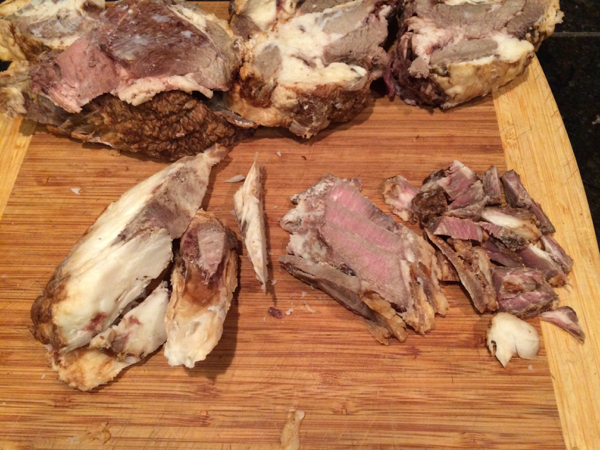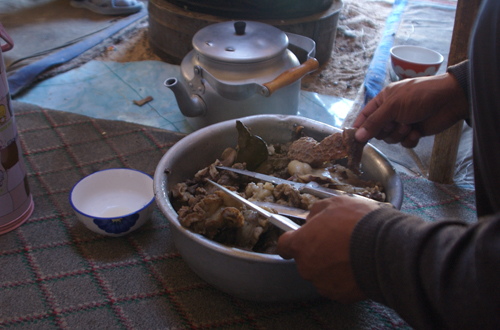
On my trip to Mongolia last year, I learned that out in the west the drivers are also the cooks. When it came time to head out into the countryside I went with him and my guide to the local Nomin Market in Hovd and helped with the shopping. It was really fun. And I learned what ingredients one can find for real Mongol food in a grocery store. I’d had the traditional noodle soup with mutton in it, but either made from scratch or served to me already done. This time I found out very useful information such as that boortz, the dried meat strips, which I’d only seen before hanging on a string tied between the roof poles of a ger, could be purchased dried, chopped up and packed in a bag ready to use! The driver also bought a few bags of dried noodles. Ah ha! Then during the trip I watched him make the soup and knew I could do it at home.
Last year, before I went to Mongolia, we had bought a ram and ended up with 108 lbs. of mutton in the freezer. In the top photo is what’s left over from the last shoulder roast we had. And a bag of noodles, half-used because I’ve made this soup once already. I knew that dishes like the soups and tsuivan (noodles with bits of mutton, mutton fat and vegies) were a way of using every last bit of meat. I set aside the big pieces for a second dinner and used the smallest pieces that were surrounded with fat. And there was plenty of it, as you can see on the left in the photo below. On the right is the leaner meat.
I’ve divided the mutton into the fat, the leftovers for the next dinner and, at the bottom, the meat and fat that will go in the soup.
Here’s the small stock pot I used with the water heating up on our gas cooktop.
This is a very simple soup: water, mutton, mutton fat, salt and I added some onion flakes, although a Mongol cook would go out and snip some wild onion. But the salt I used is from Mongolia, lake salt from Uvs Aimag, out in the northwest. I bought a couple of boxes of it at the market a couple of years ago. I had stayed in an apartment with the mother of an acquaintance that same year and saw her kitchen. Next to the stove was a lovely little birch bark container that she kept her salt in. I loved it! And later on during the trip had the great good fortune to find the container below in an Ulaanbaatar antique shop for only $15. I swear I would have paid fifty for it since it even still had its handmade wooden lid.
I happily brought it and my boxes of salt home. My host had put her salt directly into the container. But since, as far I knew, mine would be irreplaceable, I lined it with a small plastic bag. You can see the salt, which is large-grained, crumbly and very tasty.
I let all the ingredients simmer for about 30 minutes and, voila!, a pretty authentic Mongol noodle soup. It’s delicious!













